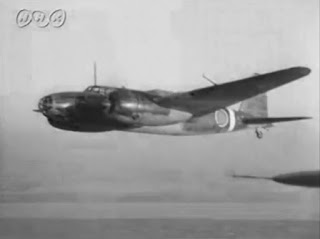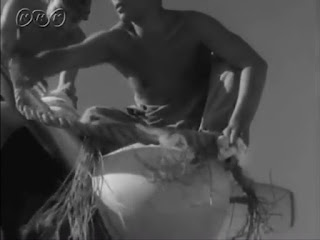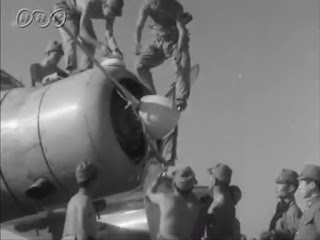Our friend Gary Wenko sent over photos of Japanese aircraft models from the Scale ModelWorld 2021 show in Telford, but due to email issues we had, they just arrived. Better late than never!
Wednesday, 26 January 2022
Wednesday, 19 January 2022
Mitsubishi Ki-21 "Sally", 58 & 60 Sentai & "Hayabusa" - video
The video from the NHK colelction, dated August 31, 1943, features Mitsubishi Ki-21 Model 2 Koh "Sally" bombers of the 58 and 60 Sentai on a raid against Chongqing.
The video starts with a sentai commander giving a speech to the pilots before getting in their aircraft. Of interest for a diorama, is the officer's building and the blackboard with the details on the course, the formation etc.
"Hayabusa" fighter pilots are checking some final details on amap before take-off. The intake under the cowling indicates that it's a Ki-43 Model 2.
The two stills above with the tails of "Sally" bombers, show the tail marking of the 58 Sentai, 1st Chutai. Three white bands, top and bottom thinner than the middle.
On the other hand, the still above features a 60 Sentai Model 2 Koh "Sally", either of the 2nd or the 3rd Chutai.
Another Ki-21 Model 2 Koh. Unfortunately the tail marking is not visible but most probably it's another 60 Sentai bomber. Note the hairyokushoku clearly visible on the undersurfaces.
Actually the raid that took place on August 23, 1943, was conducted by the 58 Sentai only, escorted by "Hayabusa" fighters from the 25th and the 33rd Sentai. About a dozen P-43s and many P-40s and other fighter types took off to intercept, and the 58 claimed two enemy aircraft shot down while admiting losiing one of the own of the 2nd Chutai.
Thursday, 13 January 2022
Yokosuka H5Y Chuo Kishodai
Our friend Peter Rathgeb sent over the following question:
I will build a 1/144 model (by A&W Models) of a Yokosuka H5Y (Type 99) Flying Boat. One of the aircraft was registered for the Central Meteorological Observatory, Yokohama (J-AAMG).
I would like to have a friend of mine make me decals for this aircraft, but I have found only one photograph, as per attachments. Do you think there are more photos to be found?
By the way, the Emily in the photo is the H8K1 13-Shi Prototype #3 converted to the Type 2 Transport Flying Boat 横鎮74 of Yokosuka Chinjufu Kokutai with the name of 敷島 Shikishima.
My answer is:
As far as I know this is the only photo that shows the aircraft in question. The name of the plane was "沖風" (Okikaze - offshore wind) so the two kanji would have been painted in white on the fuselage side next to the cockpit, similar to Emily's name.
Personally, I wouldn't dismiss painting the Okikaze overall dark blue (top and bottom surfaces) with black registration letters.
As early as 1937, when the Second Sino-Japanese War begun, and especially during the Pacific War, the vast majority of civilian aircraft that could be used by the IJAAF & IJNAF were taken over by the military and camouflaged. Most lost completely their civilian registrations and sometimes only very short inscriptions were applied on the tail to indicate the original civilian owner of the aircraft. And in general, civilian aircraft would not have been allowed to fly except in very rare occasions. Lack of fuel would be one reason.
The photo above was taken in the summer of 1944, quite late in the war, and a civilian seaplane to have survived with pristine civilian registration is extremely rare.
According to "J-BIRD", the Chuo Kishodai Yokohama (Central Meteorological Observatory, Yokohama) had the following aircraft in its fleet:
J-AAMA - Nakajima A1N, name unknown
J-AAMB - Nakajima A1N, name "Amakaze" (heavenly wind)
J-AAMC - Mitsubishi B1M, name "Umikaze" (sea wind)
J-AAMD - Nakajima A2N, name "Yamakaze" (mountain wind)
J-AAME - Mitsubishi B2M1, name "Shiokaze" (tidal wind)
J-AAMF - type unknown, name "Asakaze" (morning wind)
It is very possible the Chuo Kishodai had more aircraft in their fleet with registrations reaching J-AAMP and maybe more.
There are three known photos of Chuo Kishodai aircraft apart from the Okikaze...
 |
| J-AAMB, photo: Arawasi Collection |
 |
| J-AAMC, photo: "J-BIRD" |
 |
| J-AAMD, photo: "J-BIRD" |
...and all three of them are painted in blue.
Sunday, 9 January 2022
Saturday, 8 January 2022
Hansa W.29 twins (J-BAWI & J-BAFI) by Danilo Renzulli pt.1
These two Hansa W.29 in 1/72 scale are basically the Eastern Express kits with Rising Decals conversion sets and decal sheets.
Said the E.E. kit is the only and dated game in town it obviously means a good deal of work to do - conversion apart- the model is a bit rough and needs a lot of refining to obtain a good looking replica. A lot of time has been spent in studying and studying again the few pictures available about this subject. And since the documentation is poor I had to interpret many details.
The interiors have been enriched with Part p/e set very hardly squeezed into the thick walls of the model. In the end due to the several modifications made to resemble the Japanese W.29 version - very little was left of the original photoetchings. As one can see in the pictures the rear seats accommodations had to be completely rebuild since pretty different from the German original- this was accomplished with tiny pieces of plasticard. I also replaced the original seats with ones from a Part p/e sheet dedicated to WWI seats. The nose section had to be cut off and replaced with the Rising Decals conversion parts - here I had some troubles in fitting the exhausts.
The radiators grilles have been modified from the RD originals - retained the radiator frame only and added a fine wire mesh while some cowlings details have been rebuilt since different in each subject.
All pipes, steps, cables, etc., have been reproduced with brass rods or tubes. The windscreens have been obtained from acetate...and now the nightmare: the floats struts and bracing! . I immediately realized fitting of these parts were something more than a trouble so I decided to assemble them in separate steps. The first problems arouse in cementing and trying to align floats and the "M" struts- despite all my efforts one of the floats (J-BAWI) turned out to be misaligned and noticed this only during the photo session! Well, this revealed to be the easiest task - the worst had to come yet! Once assembled wings and fuselage, finished the surfaces and fixed all the small details I went on to prime all the parts and to paint the models in separate groups: fuselage/wings, floats and main struts, bracings. I used Mr. Color acrylic paints mixed to obtain the right colors. Once this work was done I had to apply the decals - luckly with no problems. Then I went on to attach the floats to the fuselage and again no problem. Then came the turn of the external bracings floats to outer wings' sections - the bracings, to my scorn, turned out to be too short so I had to rebuild them using brass tube. At first I built the "Z" structure in one piece only but, again, it was almost impossible to properly cement them to the locating holes due to the extremely reduced space. So once again I had to rebuild (this time in single pieces,) prime and paint the bracings and this revealed itself to be the right solution at last! It has been hard modeling but the final results are satisfactory -to me at least
Models' finish: J-BAWI is a more or less a well known and documented subject, so no problem. On the other hand J-BAFI is an almost total guess so after much reasoning and guessing I decided to go for the finish you see - the grey/blue fuselage color was chosen bearing in mind the original German finish and the poor general conditions of the aircraft as revealed by the only known picture. So, my only responsibility!
Said the E.E. kit is the only and dated game in town it obviously means a good deal of work to do - conversion apart- the model is a bit rough and needs a lot of refining to obtain a good looking replica. A lot of time has been spent in studying and studying again the few pictures available about this subject. And since the documentation is poor I had to interpret many details.
The interiors have been enriched with Part p/e set very hardly squeezed into the thick walls of the model. In the end due to the several modifications made to resemble the Japanese W.29 version - very little was left of the original photoetchings. As one can see in the pictures the rear seats accommodations had to be completely rebuild since pretty different from the German original- this was accomplished with tiny pieces of plasticard. I also replaced the original seats with ones from a Part p/e sheet dedicated to WWI seats. The nose section had to be cut off and replaced with the Rising Decals conversion parts - here I had some troubles in fitting the exhausts.
The radiators grilles have been modified from the RD originals - retained the radiator frame only and added a fine wire mesh while some cowlings details have been rebuilt since different in each subject.
All pipes, steps, cables, etc., have been reproduced with brass rods or tubes. The windscreens have been obtained from acetate...and now the nightmare: the floats struts and bracing! . I immediately realized fitting of these parts were something more than a trouble so I decided to assemble them in separate steps. The first problems arouse in cementing and trying to align floats and the "M" struts- despite all my efforts one of the floats (J-BAWI) turned out to be misaligned and noticed this only during the photo session! Well, this revealed to be the easiest task - the worst had to come yet! Once assembled wings and fuselage, finished the surfaces and fixed all the small details I went on to prime all the parts and to paint the models in separate groups: fuselage/wings, floats and main struts, bracings. I used Mr. Color acrylic paints mixed to obtain the right colors. Once this work was done I had to apply the decals - luckly with no problems. Then I went on to attach the floats to the fuselage and again no problem. Then came the turn of the external bracings floats to outer wings' sections - the bracings, to my scorn, turned out to be too short so I had to rebuild them using brass tube. At first I built the "Z" structure in one piece only but, again, it was almost impossible to properly cement them to the locating holes due to the extremely reduced space. So once again I had to rebuild (this time in single pieces,) prime and paint the bracings and this revealed itself to be the right solution at last! It has been hard modeling but the final results are satisfactory -to me at least
Models' finish: J-BAWI is a more or less a well known and documented subject, so no problem. On the other hand J-BAFI is an almost total guess so after much reasoning and guessing I decided to go for the finish you see - the grey/blue fuselage color was chosen bearing in mind the original German finish and the poor general conditions of the aircraft as revealed by the only known picture. So, my only responsibility!
- Danilo Renzulli -
Wednesday, 5 January 2022
Mitsubishi Ki-30 "Ann", 82 Dokuritsu Chutai - video
A video today from the NHK collection, dated December 1940, featuring IJA troops celebrating the coming of the new year in French Indochina.
The stills below show the troops preparing the traditional Japanese decorations for new year's celebrations.
The stills above show the preparation of kadomatsu, shimenawa and shide.In the two stills below the troops decorate their Mitsubishi Ki-30 "Ann" light bombers with shimenawa.
And also place two and three tier mochi called kagami mochi.
The tail marking seen in the stills indicates that the unit is the 82 Dokuritsu Chutai. The marking comprised a red "river" with a white kanji in the middle. In this case, it's the kanji "内" ("uchi/nai" meaning inside/interior), and was probably the first kanji of the shotai leader's name. For example "Naito" or "Uchida").
On November 25, 1940, as part of the "Japanese Invasion of French Indochina", the 21 Dokuritsu Hikotai, with the 82 Dokuritsu Chutai equipped with "Ann" and the 84 Dokuritsu Chutai equipped with Mitsubishi Ki-27 "Nate" fighters, was assigned to present-day Vietnam and was based at the Gia Lam airfield, Hanoi.
The 82 Dokuritsu Hikotai used this tail marking until October 15, 1942, when it was reorganized as the 34 Sentai.
For more "cultural" info, check our Facebook page: Arawasi | Facebook
Subscribe to:
Posts (Atom)





















































